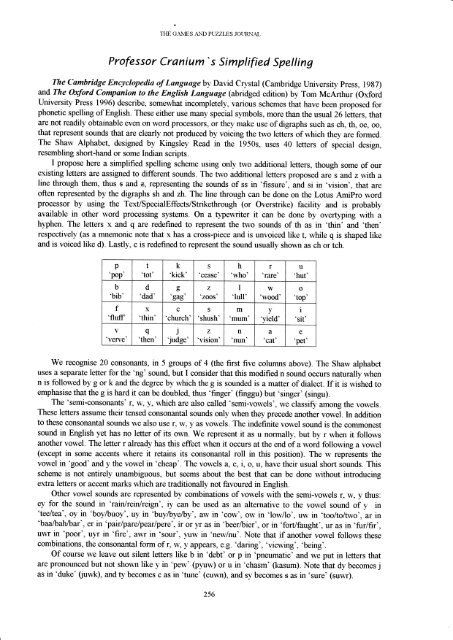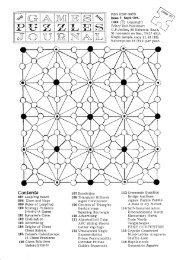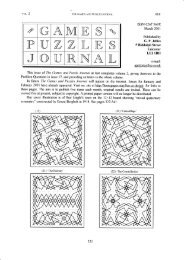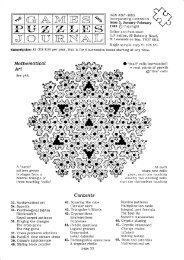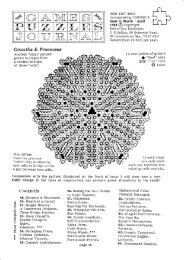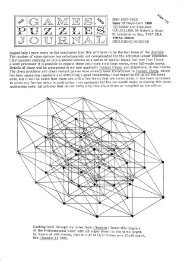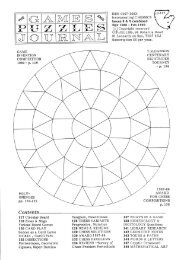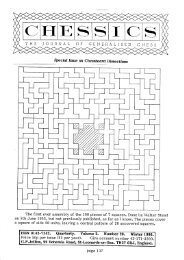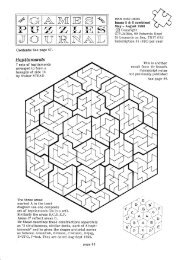The Games and Puzzles Journal, #15 - Mayhematics
The Games and Puzzles Journal, #15 - Mayhematics
The Games and Puzzles Journal, #15 - Mayhematics
You also want an ePaper? Increase the reach of your titles
YUMPU automatically turns print PDFs into web optimized ePapers that Google loves.
THE CAMES AND PUZZLES JOI]RNAL<br />
Professor Cranium' s Simplified Spelling<br />
<strong>The</strong> Cambridge Encyclapedia of Language by David Crystal (Cambridge University Press, l98T)<br />
ard <strong>The</strong> Oxford Companion to the English Language (abridged edition) by Tom McArthur (Oxford<br />
University Press 1996) describe, somewhat incompletely, various schemes that have been proposed for<br />
phonetic spelling of English. <strong>The</strong>se either use many special symbols, more than the usual 26 letters, that<br />
are not readily obtainable even on word processors, or they make use of digraphs such as ch, th, oe, oo,<br />
that represent sounds that are clearly not produced by voicing the two letters of wtrich they are formed.<br />
<strong>The</strong> Shaw Alphabet, designed by Kingsley Read in the 1950s, uses 40 letters of special desrgn,<br />
resembling short-h<strong>and</strong> or some Indian scripts.<br />
I propose here a simplified spelling scheme using only two additional letters, though some of our<br />
existing letters are assigned to different sounds. <strong>The</strong> two additional letters proposed are s <strong>and</strong> z with a<br />
line through them, thus s <strong>and</strong> z, representing the sounds of ss in 'fissure', <strong>and</strong> si in 'vision', that are<br />
often represented by the digraphs sh <strong>and</strong> zh. <strong>The</strong> line through can be done on the Lotus AmiPro word<br />
processor by using the Text/SpecialEffects/Strikethrough (or Overstrike) facilrty <strong>and</strong> is probably<br />
available in other word processing systems. On a typewriter it can be done by overtyping with a<br />
hyphen. <strong>The</strong> letters x <strong>and</strong> q are redefined to represent the two sounds of th as in 'thin' <strong>and</strong> 'then'<br />
respectively (as a mnemonic note that x has a cross-piece <strong>and</strong> is unvoiced like t, while q is shaped like<br />
<strong>and</strong> is voiced like d). Lastly, c is redefined to represent the sound usually shown as ch or tch.<br />
p<br />
'pop'<br />
t<br />
'tot'<br />
k<br />
'kick'<br />
S<br />
'cgasg'<br />
h<br />
otrYho'<br />
r<br />
'rarg'<br />
u<br />
'hut'<br />
b<br />
'bib'<br />
f<br />
'fluff<br />
Y<br />
'Yeft'g'<br />
d<br />
'dad'<br />
X<br />
'thin'<br />
q<br />
'then'<br />
g<br />
'gag'<br />
c<br />
'church'<br />
j<br />
Judge'<br />
Z<br />
'zoos<br />
s<br />
'shush'<br />
7.<br />
'vision<br />
1<br />
'lull'<br />
m<br />
'mum<br />
n<br />
'nun'<br />
\ry<br />
'$'ood'<br />
v<br />
-yield'<br />
a<br />
'cat'<br />
o<br />
'top'<br />
1<br />
'sit'<br />
e<br />
'pet'<br />
We recognise 20 consonants, in 5 groups of 4 (the first five columns above). <strong>The</strong> Shaw alphabet<br />
uses a separate letter for the 'ng' sound, but I consider that this modified n sound occurs naturally when<br />
n is followed by g or k <strong>and</strong> the degree by which the g is sounded is a matter of dialect. If it is wished to<br />
ernphasise that the g is hard it can be doubled, thus 'finger' (finggu) but 'singer' Gingu).<br />
<strong>The</strong> 'semi-consonants' r, w, y, which are also called 'semi-vowels', we classi$, arnong the vowels.<br />
<strong>The</strong>se letters assume their tensed consonantal sounds only when they precede another vowel. In addition<br />
to these consonantal sounds we also use r, w, y as vowels. <strong>The</strong> indefinite vowel sound is the commonest<br />
sound in English yet has no letter of its own. We represent it as u normally, but by r when it follows<br />
another vowel. <strong>The</strong> letter r already has this effect wheir it occurs at the end of a word following a vowel<br />
(except in some accents where it retains its consonantal roll in this position). <strong>The</strong> w represents the<br />
vowel in 'good' <strong>and</strong> y the vowel in 'cheap'. <strong>The</strong> vowels 4 e, i, o, u, have their usual short sounds. This<br />
scheme is not entirely unambiguous, but seems about the best that can be done without introducing<br />
extra letters or accent marks which are traditionally not favoured in English.<br />
Other vowel sounds are represented by combinations of vowels with the semi-vowels r, w, y thus:<br />
ey for the sound in 'rain/rein/reigr', iy can be usd as an alternative to the vowel sound of y in<br />
'tee/t&a', oy in 'boy/buoy', uv in 'buy/bye/by', aw in 'cow', ow in 'lowllo', uw in 'too/toltwo', al in<br />
'baa/bahlbar', er in 'pur/pare/pear/pere'" ir or g as in 'beer/bier', or in 'fort/faught', ur as in 'fur/fir',<br />
uwr in 'poor', ulr in 'fire', awr in 'sour', ).uw in 'nednu'. Note that if another vowel follows these<br />
combinations, the consonantal form of r, \,v, y appears, e.g. 'daring', 'viewing', 'being'.<br />
Of course we leave out silent letters like b in 'debt' or p in 'pneumatic' <strong>and</strong> we put in letters that<br />
are pronounced but not shown like y in 'pew' (pJuw) or u in 'chasm' (kasum). Note that dy becomes j<br />
as in 'duke' (uwk), <strong>and</strong> ty becomes c as in 'tune' (cuwn), <strong>and</strong> sy becomes s as in 'sure' (suwr).<br />
256


